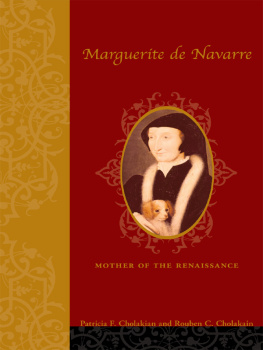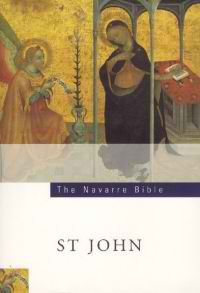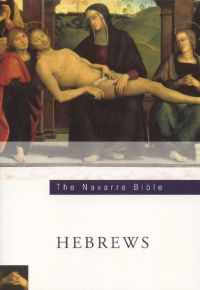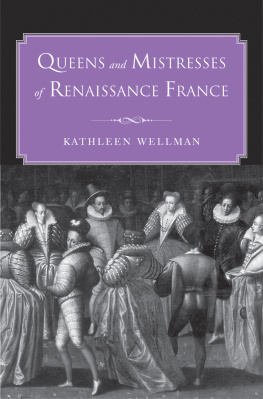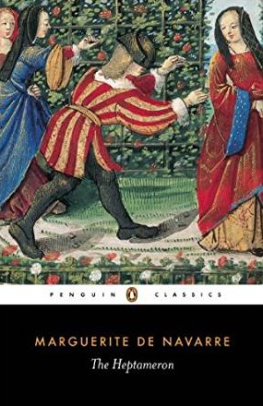Marguerite de Navarre
Marguerite de Navarre
MOTHER OF THE RENAISSANCE
Patricia F. Cholakian and
Rouben C. Cholakian
COLUMBIA UNIVERSITY PRESS NEW YORK
Columbia University Press
Publishers Since 1893
New York Chichester, West Sussex
cup.columbia.edu
Copyright 2006 Columbia University Press
All rights reserved
E-ISBN 978-0-231-50868-1
Library of Congress Cataloging-in-Publication Data
Cholakian, Patricia Francis.
Marguerite de Navarre : mother of the Renaissance / Patricia F. Cholakian and Rouben C. Cholakian
p. cm.
Includes bibliographical references and index.
ISBN 0-231-13412-6 (cloth : alk. paper)
1. Marguerite, Queen, consort of Henry II, King of Navarre, 1492-1549.
2. QueensNavarre (Kingdom)Bibliography.
3. Authors, French16th centuryBiography.
I. Cholakian, Rouben Charles, 1932 II. Title.
DC112.M2C56 2005
946'.52042'092dc22
[B] 2005048438
A Columbia University Press E-book.
CUP would be pleased to hear about your reading experience with this e-book at .
Patricia F. Cholakian, 1933-2003
Scholar and Companion
Non inferiora sequor
Contents
The biographers task is always a formidable one, for any human being is ultimately unknowable, no matter how many facts one gathers about her. But when one is reconstructing the life of a woman who lived in a timefive hundred years agoand a milieuthe French royal courtso different and so far removed in every way from twenty-first century America, then it becomes nearly overwhelming. Official records document the comings and goings of a woman like Marguerite de Navarre, who lived in historys limelight, but it is extremely difficult to get any sense from these of what she was really like, what she thought and felt, or how she lived her day-to-day existence. To do that it is necessary to find primary sources, which are usually very rare. In Marguerites case, however, we are privileged, for her writingsher poems, plays, and the collection of novellas known as the Heptamronare a gold mine of information. Yet, strangely, they have not really been explored for their biographical implications. Our aim here is to do just that, to supplement what can be learned about the official and public Marguerite of archival sources with what can be gleaned from her writings. For we firmly believe that just as her life undoubtedly shaped what she wrote, what she wrote offers some insight into who she was.
As we are well aware, such an enterprise is not without peril, for it must rely heavily on conjecture. The most literal-minded critics will reject many of our conclusions, aligning themselves with Marguerites first serious modern biographer, Pierre Jourda, who refused to acknowledge the veracity of any text not supported by incontrovertible historical evidence; to them we can only reply that it has always been common practice for writers to camouflage personal experience with fictitious details. Others, although they do not argue that the autobiographical must coincide in all respects with the historical, may disagree with our deductions; in reply to them, we promise that we will provide as much documentation as possible to support our conclusions, and that we will always endeavor to make it clear when we are dealing with fact and when we are advancing our own hypotheses.
We also realize that the text, any text, even one that outwardly purports to be autobiographical, is subject to the ambiguities inherent in all forms of expression. There are not only the inevitable gaps that students of language readily acknowledge between words and the ideas they convey, but the important breach between conscious and unconscious intention that modern psycholinguists have more recently brought to our attention. Meaning, they tell us, is forever visible and invisible. Without wanting to turn our biography into a labyrinth of psychological double-talk, we intend to keep these cautionary remarks in mind.
We have embarked on this project because no up-to-date biography of Marguerite de Navarre exists in English, in spite of the fact that, thanks to feminisms reevaluation of early texts by women, she is now viewed as one of the most important writers of her timethe ideal and unequalled ancestor of the greatest women of letters, as Pierre Jourda has called her. For while her writings are at last receiving the scholarly attention they merit, her life continues to be viewed through the prism of the life of her brother, Franois I, the French Renaissance king who admittedly deserves much credit for turning France into a modern nation and his court into an artistic mecca. But history is only now beginning to acknowledge the significant role in these achievements also played by Franoiss brilliant sister, Marguerite; it is our earnest hope in these pages to draw attention to the need for reassessing her contributions.
This is not to say that the Queen of Navarre has been totally neglected as a biographical subject. The year after her death, a devoted officer of her household, the poet Charles de Sainte-Marthe, delivered a funeral oration that eulogistically recounted the life of his patroness. Although often overstated and embellished, his remarks are nevertheless valuable as an evaluation of how Marguerite was viewed by her contemporaries. And at the end of the century, Pierre de Bourdeille, abbot of Brantme, importantly included the Queen of Navarre in his two-volume social history of French royal women, Recueil des dames (166566 [posthumous]; Ladies stories). No one who wishes to write about Marguerite can overlook this priceless documentation. As we shall see, much of what we are able to reconstruct about the Heptamrons autobiographical elements can only be corroborated thanks to Brantmes remarks.
In more recent times, in the nineteenth and early twentieth centuries, the Queen of Navarre has been regularly featured in gender-specific anthologies with titles like Ladies of the Reformation (1857), Les Femmes de la cour des derniers Valois (1870; Women in the court of the last of the Valois), Les Femmes de lettres en France (1890; Women writers in France), Five Famous French Women (1905), or Famous Women of France (1941). It is fair to say, however, that very little of what appears in these superficial biographical essays provides much that is worthy of serious attention. They invariably fall into what the French disparagingly call petite histoire.
As to full-length biographies, perhaps her gender did inspire some women biographers to choose her as a subject, for three of them wrote books about her in the nineteenth centurya French countess, Louise de Broglie Haussonville (1870); and two Englishwomen, Mary Robinson (1886 and 1900) and Martha Walker Freer (1895)whereas only one man, Victor Luro (1866), did so. And in the twentieth century, there are the biographies by Hedwige de Chabannes (1973), Nicole Toussaint du Wast (1976), and Marie Cerati (1981), although, curiously, there are more by men: in English, H. Noel Williamss (1916), and Samuel Putnams (1936); and in French, not only Jourdas massive work (1930) but more recently, Jean-Luc Djeans (1987). While many of these works are informative as well as engaging, except for Jourdas they tend to suffer from two weaknesses: either they embed Marguerites story in the history of the reign of Franois I, with the result that they end up telling his story rather than hers; or they appeal to the popular taste for royal gossip, often failing to document sources or to distinguish fact from legend.

